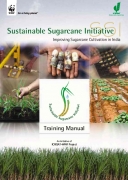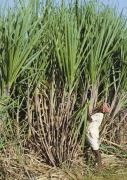 Sustainable Sugarcane Initiative (SSI) is an approach to the cultivation of sugarcane, that can reduce inputs - water, chemical fertilizers, seed material and farm space - while improving sugarcane production significantly. It also reduces crop duration and provides a longer period of the cane crushing season to the sugar industry.
Sustainable Sugarcane Initiative (SSI) is an approach to the cultivation of sugarcane, that can reduce inputs - water, chemical fertilizers, seed material and farm space - while improving sugarcane production significantly. It also reduces crop duration and provides a longer period of the cane crushing season to the sugar industry.
This farm-based approach (as opposed to crop-based) also gives farmers options to grow intercrops, such as pulses to improve their income. Most importantly, SSI reduces the overall pressure on water resources and contributes to recovery of ecosystems. It conserves soil moisture, thereby allowing for growing of dryland crops in the same region.
SSI is inspired from the successful approach of System of Rice Intensification (SRI) paddy cultivation, which like SSI, originated from farmers and civil society to improve agricultural productivity while reducing pressure on natural resources.
Main sections in the manual
This training manual developed by WWF India and ICRISAT, is a step-wise guide to SSI practices, covering bud selection and treatment, nursery raising, main field preparation, transplantation, weeding, mulching, fertiliser (organic / non-organic) application, water management, earthing up, detrashing, propping, plant protection, intercropping and harvesting. It also has special sections on pit planting method of cultivation and ratoon management, and its annexures have drawings and size details of nursery shade nets.
Major principles and benefits of SSI
- Raising nursery using single-budded chips (conventionally, 2-3 budded sets are used and normally no nursery is prepared).
- Transplanting young seedlings (25-35 days old), after grading (conventionally, direct planting of 3-budded chips is done). Raising a nursery and grading reduces plant mortality significantly as compared to conventional cultivation.

- Maintaining wide spacing (5 x 2 feet) in the main field, which reduces the seed requirement by 75% from 48,000 (16000 3-budded chips) to 5000 single-budded chips per acre (conventional spacing is 1.5 x 2.5 ft). Wider spacing supports easy air and sunlight penetration in the crop canopy, leading to better and healthier cane growth. It also allows for easier intercultural operations.
- Providing sufficient moisture and avoiding inundation of water, whereby 40% of water is saved (conventionally, flooding is practiced). This is significant as sugarcane consumes about 2500L of water per kg of sugarcane produced.
- Encouraging organic methods of nutrient management and plant protection.
- Practicing intercropping (which is possible due to wider spacing and non-flooding), thereby increasing effective utilization of land, giving additional income and reducing weed growth by 60%.
- All of the above practices, lead to increased length and weight of individual canes, and alteast 20-25 tillers/plant and 9-10 millable canes/plant, as compared to 10-15 tillers and 4-5 millable canes in conventional cultivation.
Why is SSI important?
In India, the importance of sugar and sugarcane cannot be understated. It is a Rs. 30,000 crore industry, the second largest in the agro-processing sector, next only to textiles, and represents the principal livelihood of 35 million farmers, and 50 million others who are employed in its 571 sugar-related industries.
India has the second largest area under sugarcane in the world, producing about 355 million tonnes, covering 41 lakh hectares, with a low average productivity (as low as 40 tonnes/hectare) and a low cane/sugar extraction ratio of 10%, as compared to global standards. It is also the largest consumer of sugar, consuming about 200 lakh tonnes (all figures as of 2007-08).
From the point of view of water, sugarcane consumes about 2500 L of water per kg, and along with paddy, consumes the maximum proportion of water utilised in agriculture, and hence also of the total water consumed, since agriculture itself as a sector consumes about 70-80% vis-a-vis other sectors.
Hence, more-from-less sustainable agriculture approaches such as SSI (and SRI) which can deliver higher production, at lower economic and ecological costs (including a lower water footprint), have a very significant role to play in shaping the future of our farmers, food security and economy.
Download the manual:





 ssi_training_manual_wwf_icrisat_2009.pdf
ssi_training_manual_wwf_icrisat_2009.pdf







